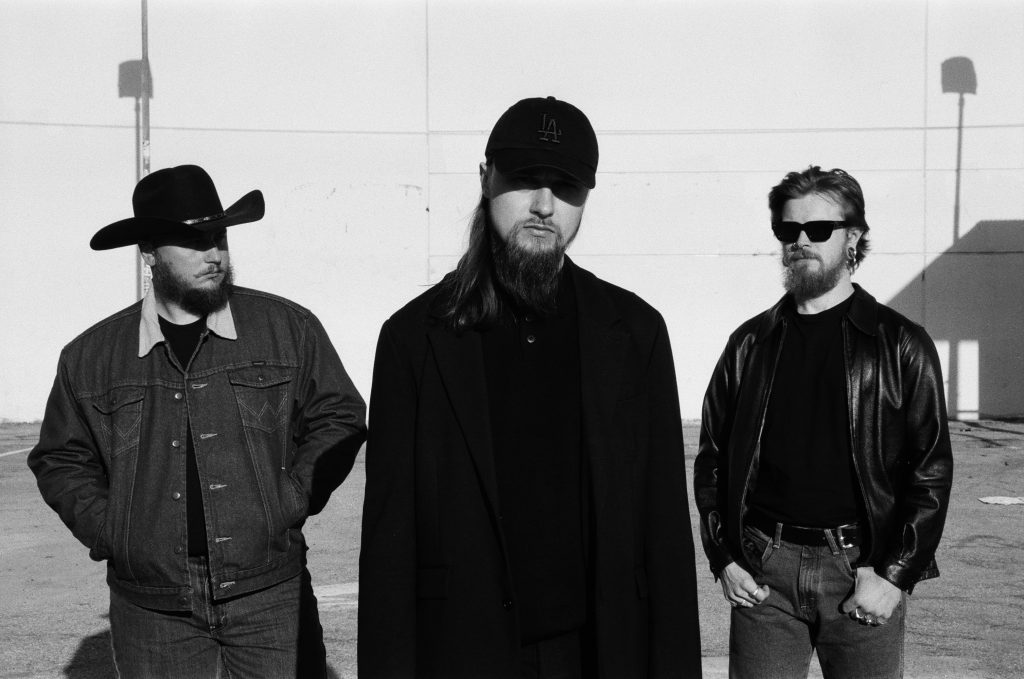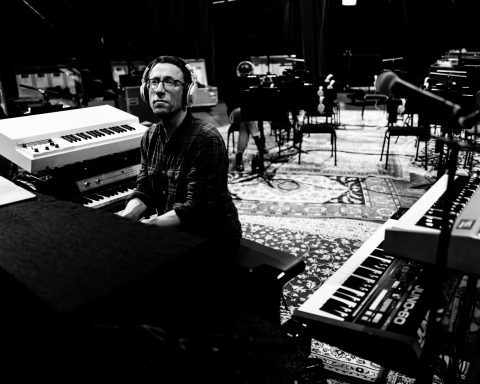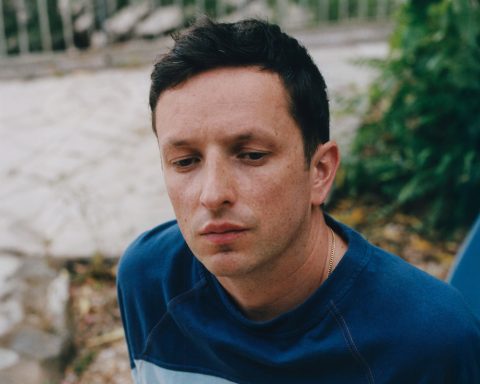Founded in Minsk, Belarus, post-punk/synth-pop trio Molchat Doma made waves with their gritty, lo-fi ’80s sound on albums Etazhi (2018) and the more poppy but equally disembodied Monument two years later. Both releases gained popularity online as their audience rapidly expanded beyond Eastern Europe and into Latin America and the US. On their fourth album, Belaya Polosa, out now on Sacred Bones, Molchat Doma presents a far more polished and refined sound, nodding towards the dark synth rock of mid-’90s Depeche Mode while retaining their unmistakable dystopian aesthetic. Now based in Los Angeles, guitarist and synth addict Roman Komogortsev discusses the band’s fascination for brutalist architecture and its latest sonic reinvention before heading out on tour later this month.
Band Formation
Did the band’s initial influences come from Eastern Europe or further afield?
The first band that inspired me to pick up a guitar was Kino. I studied all their songs and taught myself to play based on their chords and melodies. Later, I moved on to heavier music like Metallica, Motorhead, and Judas Priest, but the band wasn’t formed until I met Egor at college. He was listening to Radiohead and Red Hot Chili Peppers and was into European trance, but we both agreed on liking Warpaint and Rage Against the Machine and started making music on an old Lenovo laptop with a faulty M-Audio Fast Track soundcard and pair of Tannoy monitors. Egor learned to play a cheap bass guitar, I played an Epiphone SG Special on the first two albums, and we found some free synthesizer plugins and samples online.
When you began playing festivals, did you get to meet some artists who inspired you?
One of the most memorable and important moments was getting to talk to Gary Numan, who has been such a huge inspiration. We were performing at the Cruel World Festival, and as we were finishing our set, I caught a glimpse of him watching backstage. After the performance, he approached Egor and said, “Nice set, guys!” We later gathered the courage to approach him and ask for a photo and autograph. I’d also love to meet Trent Reznor and Jimmy Page and ask them about technical stuff and how they perceive and listen to music.
How important was social media to the rise in Molchat Doma’s popularity?
Social media was crucial to us getting noticed by our first label and how people learned about us around the world. When we started, the social network vk.com was popular in our region, so after our first concert we created a group there and uploaded our music. Gradually, people began joining, and then word of mouth took over. Our popularity has always been strong in Latin America, the US, and Europe. We weren’t listened to as widely in Eastern Europe, but this is gradually starting to even out.
Brutalist Architecture
Have your lyrics or the things you sing about changed significantly up to and including your latest LP, Belaya Polosa?
We’ve always tried to sing about the things that matter to us or situations and experiences that are our own. For Belaya Polosa, we had something specific to talk about because, as I’m sure you understand, we’ve gone through some significant life changes and wanted to tell that story. Our cover art has become a signature of ours, too, and we’ve decided not to stray from the tradition of using brutalist architectural imagery.

“For Belaya Polosa, we had something specific to talk about because, as I’m sure you understand, we've gone through some significant life changes.”
In what way does brutalist architecture correlate to how you think about music?
In the early stages of our creativity, we were inspired by the visual aspect of Soviet aesthetics. In the former Soviet Union, there are many brutalist buildings that reflect that era. We view our music through the lens of these structures, which seem to perfectly reflect the essence of our sound: detached, desolate, and depressive.
From the ’80s to the ’90s
Belaya Polosa sounds more polished than previous LPs. Is that down to having more modern equipment or a more sophisticated understanding of how to make a record?
It’s a combination of factors. We’ve improved as musicians and have a better understanding of how songs work and how to make them. And, of course, we’re interested in experimenting, which has led us to create a more diverse sound. Initially, we had this concept of making albums tied to specific time periods. Roughly speaking, our previous work was oriented towards the early ’80s and then the late ’80s. With Belaya Polosa, we’ve decided to step into a new era, the ’90s, and associate our sound with that period.
Is there a primary songwriter in the band who writes demos, or do you prefer to work collectively?
I primarily write music and create demos, and then what often happens is that we get together and start jamming until the songs fully emerge. Usually, everything starts with a bass line or the main melody. We do use software but prefer to be inspired by live instruments—there’s just something about the experience you get from turning real faders or pressing real keys on a physical instrument.
“We've decided to step into a new era, the '90s, and associate our sound with that period.”
Synth Collector
When did you first start collecting synths, and what were some of your earliest acquisitions?
I started collecting synthesizers in 2017, and my first acquisition was a DX7 MK1, which I was very happy with. But then I got influenced by my friend Igor Starshinov, a well-known electronic musician and synth collector. The first time I visited his studio, I was amazed by all the vintage gear he had, like the Roland D-50, Roland JUPITER-6, and TR-909. Since then, I started collecting, but due to our geographical location, many of the vintage synthesizers were quite hard to find.
At the moment, I don’t need those synths because since we’ve been in Los Angeles, I’ve gathered some new instruments and slightly changed my approach to making music, but I still have a fairly large collection back in Minsk. We brought over the MPC One and Roland SP-404SX samplers and a Prophet-5, everything else, including all of the instruments we use for touring were bought here, so we basically set up the studio from scratch.
Roland synths are quite prominent in your collection. Which ones stand out for you?
Most of our music has and continues to be made up of synths and various drum machines from Roland. My favorite one—the V-Synth—is still in Minsk, unfortunately, but I hope to bring it over someday. It’s a very cool instrument for sound design and was a bit ahead of its time because it had a very futuristic feel. We love Roland because whether we’re using a vintage or brand new synth, they seem to have a unique, or shall we say, distinct signature.
“I mainly use Roland Cloud synthesizers when coming up with new songs.”
Cloud Cover
Which Roland Cloud plug-ins are you currently using, and at what point in the production process might you employ them?
I mainly use Roland Cloud synthesizers when coming up with new songs. I love the SH-101 emulation, the JUNO series, the TB-303, and basically all of the classic Roland drum machines from the TR-808 to the 909 and 727. I also really like the JD-800 VST. I used to own the real one, and it’s an amazing synthesizer. When it comes to hardware drum machines, we still use the CR-68 rhythm box when jamming and during our acoustic sets. It’s about inspiration. When you need to create a simple rhythm to get you started, the CR-68 does the job perfectly.
The track “Chernye Tsvety” shows a softer side to Molchat Doma. What can you tell us about the direction you wanted to take on this track?
“Chernye Tsvety” was inspired by the Depeche Mode album Songs of Faith and Devotion and the track “Walking in My Shoes” in particular. I feel it has a similar spirit, and we specifically wanted to try using drum samples and loops that we hadn’t used before. We want to move away from the ’80s era and start a new chapter in our sound, and that’s naturally led us to the ’90s because it’s a period that resonates deeply. I spent a lot of time studying how music was mixed in studios during the ’90s, and that influenced our choice of equipment and the instruments that played a big role in creating this album.







